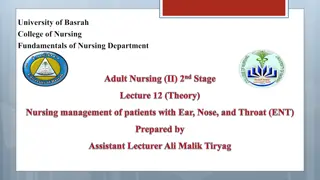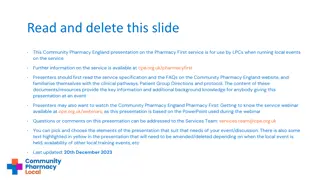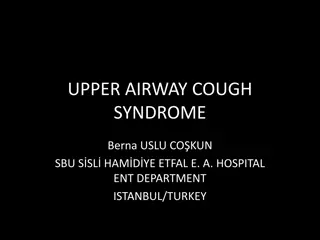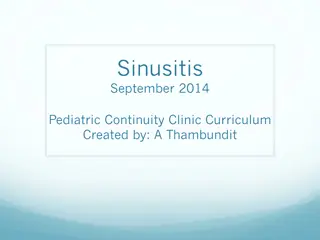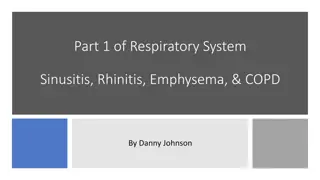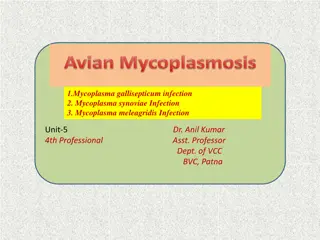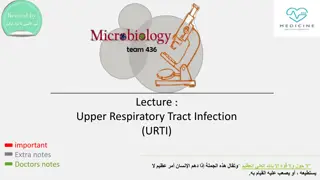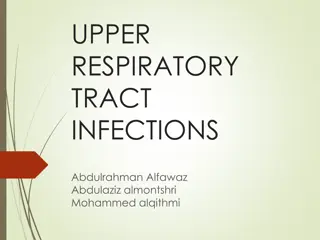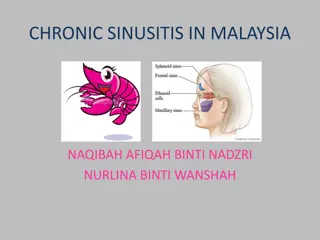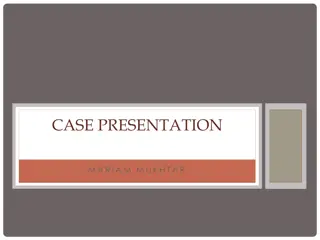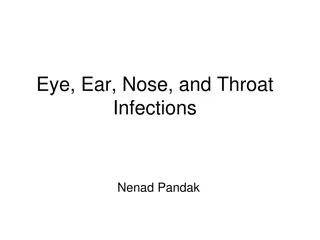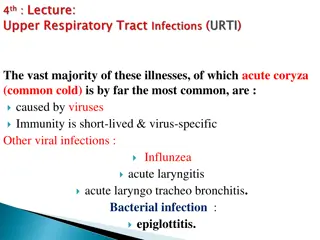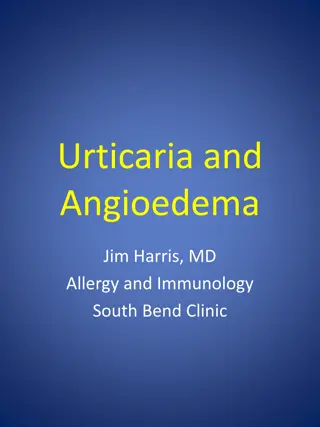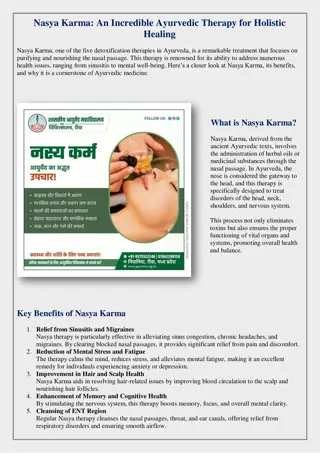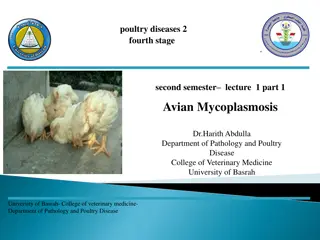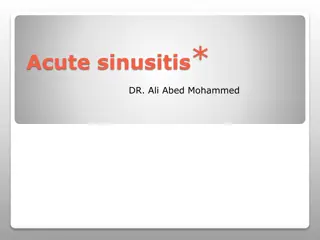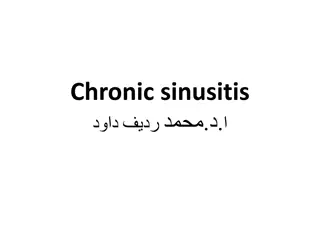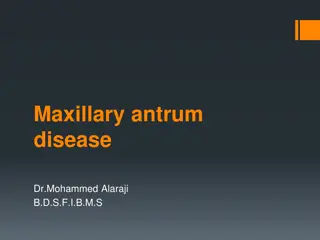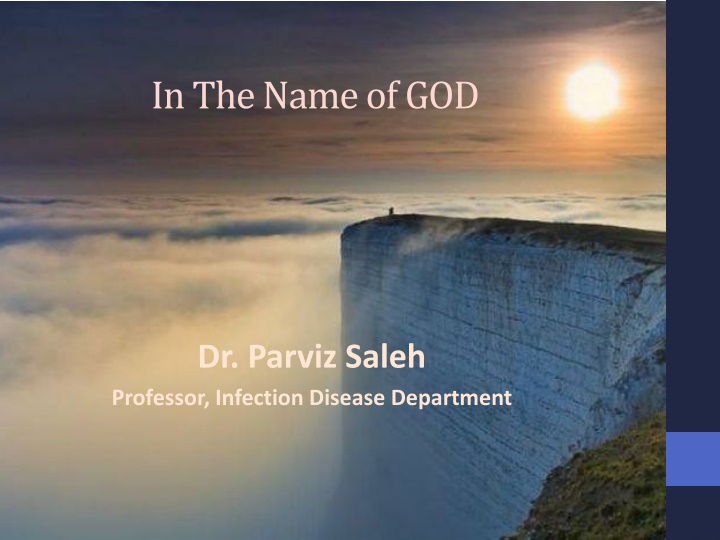
Sinusitis: Causes, Symptoms, and Epidemiology
Explore the pathogenesis, microbiology, and clinical manifestations of sinusitis, a common condition categorized as acute or chronic inflammation of the sinuses. Learn about the epidemiology and risk factors associated with sinusitis diagnosis, highlighting the impact on adults and women. Discover the similarities and differences between sinusitis and viral upper respiratory infections to better understand the condition.
Download Presentation

Please find below an Image/Link to download the presentation.
The content on the website is provided AS IS for your information and personal use only. It may not be sold, licensed, or shared on other websites without obtaining consent from the author. If you encounter any issues during the download, it is possible that the publisher has removed the file from their server.
You are allowed to download the files provided on this website for personal or commercial use, subject to the condition that they are used lawfully. All files are the property of their respective owners.
The content on the website is provided AS IS for your information and personal use only. It may not be sold, licensed, or shared on other websites without obtaining consent from the author.
E N D
Presentation Transcript
In The Name of GOD Dr. Parviz Saleh Professor, Infection Disease Department
Sinusitis Sinusitis may be classified as acute or chronic. PATHOGENESIS Of these multiple causes, viral infection of the upper respiratory tract and allergic inflammation are the most frequent and most important.
MICROBIOLOGY puncture through a transnasal approach. an endoscope sinus puncture remains the gold standard in investigating the microbiology of sinusitis in children. S. pneumoniae is the most frequently isolated organism, followed by nontypeable H. influenzae and M. catarrhalis. Streptococci, Staphylococcus aureus, and anaerobes are isolated much less frequently (Table 63-3). In children with acute bacterial sinusitis, M. catarrhalis is isolated with a greater frequency than in adults. The role of S. aureus in the etiology of sinusitis has been controversial.
CHRONIC SINUSITIS is defined as symptoms and signs of sinus inflammation that persist for at least 12 weeks. The same bacterial species (S. pneumoniae and H. influenzae) that are found in acute sinus disease are occasionally found in chronic sinusitis, especially in patients with acute exacerbations of chronic sinusitis. Other bacteria such as S. aureus, gram-negative enteric organisms, and anaerobes have been isolated with a greater frequency in sinus puncture studies.
EPIDEMIOLOGY Sinusitis is diagnosed more frequently in adult women than men at a ratio of 1.8 : 1.80 Risk factors for the development of sinusitis include allergic rhinitis and asthma, swimming, and nasal obstruction due to polyps, foreign body, and tumor A weak association between gastroesophageal refluxdisease and sinusitis has been documented
CLINICAL MANIFESTATIONS Because the pathogenesis of sinusitis and viral URI are similar, the clinical manifestations of these two diseases overlap greatly and must be compared. Nasal symptoms such as congestion and discharge are prominent in viral URI. Mild fever, when present, usually occurs in the first 48 hours of illness and is more common in children presenting with URI than adults. The clinical presentation of acute community-acquired bacterial sinusitis falls into one of three predictable patterns.83 The first pattern is that of persistent symptoms characterized by nasal discharge and/or cough that last more than 10 days without improvement. It is expected that the symptoms of a viral URI will have improved by the 10-day mark. Therefore, it is the lack of improvement that is a sign of an acute bacterial process.
The second presentation is characterized by the onset of severe symptoms. Fever will accompany purulent nasal discharge that is present over a 3- to 4-day period.84 These patients often appear ill. Worsening symptoms, referred to as double sickening in the Scandinavian literature, characterize the third presentation. These patients have an initial regression of symptoms of cough, nasal discharge, and congestion but then worsen again within the first 10 days of illness.83,85 Worsening may be signaled by new onset of fever, increasing nasal discharge, congestion, or daytime cough.
Patients with chronic rhinosinusitis have symptoms for at least 12 weeks. The presentation of such patients is characterized by anterior or posterior mucopurulent drainage and nasal obstruction. Facial pain or pressure, as well as hyposmia, are frequently present in patients with chronic sinus disease. The physical examination is of limited utility in the diagnosis of acute sinusitis mainly because of the similarity of findings between patients with a viral URI and those with a bacterial process. Mucopurulent discharge may be found on the nasal mucosa. The mucosa itself is erythematous and mildly edematous. Facial tenderness over the maxillary or frontal area may be present but is an unreliable finding. Periorbital edema and mild discoloration of the skin below the eyelids can be signs.
Clinical Diagnosis The challenge to the clinician when faced with the patient with upper respiratory symptoms is to identify those patients who have acute bacterial sinusitis and thus would benefit from an antimicrobial agent. The duration of respiratory symptoms is the single most useful factor in discerning which patients have probable acute bacterial sinusitis. Studies on the microbiology of sinusitis in children showed that if rhinorrhea persisted at least 10 days with no improvement, bacterial burden in the sinuses was high. Sinusitis is best diagnosed on the basis of the type, duration, and severity of symptoms. In children, persistent cough, especially when present during the daytime, may also be a signal of bacterial infection of the paranasal sinuses. The following three clinical presentations will identify patients with acute bacterial sinusitis: (1) onset with persistent symptoms or signs, lasting at least 10 days without evidence of clinical improvement;(2) onset with severe symptoms or signs of high fever ( 39 C) and purulent nasal discharge lasting for 3 to 4 consecutive days; and (3) onset with worsening symptoms or signs characterized by the new development of fever, headache, or increased nasal discharge after a typical viral URI that lasted 5 to 6 days with initial improvement ( double sickening ).
Imaging Although historically imaging (plain film radiography, CT, magnetic resonance imaging [MRI], and ultrasonography) have been used as a confirmatory or diagnostic modality in patients suspected to have acute bacterial sinusitis, it is no longer recommended. When an individual experiences a viral URI, there is inflammation of the nasal mucosa and often the mucosa of the middle ear and paranasal sinuses as well. The authors concluded that the common cold is associated with frequent and striking anatomic involvement of the paranasal sinuses including air-fluid levels. Accordingly, an abnormal image cannot confirm the diagnosis of acute bacterial sinusitis and is not necessary to perform in patients with uncomplicated episodes of clinical sinusitis. In summary, the diagnosis of acute sinusitis should be made on clinical grounds in most patients. CT of the sinuses is useful for the evaluation of patients with intraorbital or intracranial complications. MRI may have a role in the diagnosis of fungal sinusitis and is useful in the diagnosis of the intracranial complications of sinusitis.
THERAPY Antimicrobial Antibacterial agents are the primary therapy for acute bacterial sinusitis. In the past 40 years, there have been numerous randomized, placebo-controlled trials of antimicrobials in patients with sinusitis. These trials have shown variable benefit to antibiotics over placebo. Further complicating the interpretation of antimicrobial efficacy studies is the fact that patients with sinusitis will have a high rate of spontaneous improvement within 2 weeks of presentation. Studies that included patients who had more severe or prolonged symptoms (i.e.,>10 days), or those that used adjunctive diagnostic tests to confirm the diagnosis of sinusitis, were more likely to show a benefit to antimicrobials versus placebo
those who received antimicrobials show a more rapid improvement in symptoms compared with patients receiving placebo. Overall, antimicrobial agents reduce the rate of clinical failure 25% to 30% within 7 to 14 days of initiating Therapy Diarrhea is the most common adverse event noted and is usually self- limited.Most recommend that antibiotics be prescribed for those patients with clinically diagnosed acute sinusitis. The IDSA guideline recommends amoxicillin/clavulanate as first line for the treatment of sinusitis. The AAP guidelines recommend amoxicillin with or without clavulanate. Patients who present with severe sinus disease or complications of sinusitis should be managed with parenteral antimicrobial therapy. Patients who have mild or moderately severe sinusitis may be treated with an oral antibiotic. Antimicrobial therapy is directed at the three major pathogens of sinusitis: S. pneumoniae, H. influenzae, and M. catarrhalis. If the proportion of patients infected with S. pneumoniae that are nonsusceptible to penicillin are decreasing, then standard-dose amoxicillin (45 mg/kg/day) rather than high-dose amoxicillin (80 to90 mg/kg/day, maximum 4 g/day) may be used.
However, if rates of isolation of -lactamase-producing H. influenzae are increasing, then a -lactamase-stable drug such as amoxicillin/clavulanate or an advanced-generation cephalosporin would be indicated. For most adults and children, amoxicillin with or without clavulanate remains an excellent first-line agent. High-dose amoxicillin or high-dose amoxicillin/clavulanate (2 g orally twice daily) should be used when the patient is at high risk for penicillin nonsusceptible S. pneumoniae ( 10% nonsusceptible pneumococci, attendance at day care, age younger than 2 years or older than 65 years, recent hospitalization, antibiotics in the past month). In the child with a significant penicillin allergy, cefdinir, cefuroxime, or cefpodoxime proxetil may be used. Alternative agents in adults include a respiratory fluoroquinolone (such as levofloxacin or moxifloxacin) or doxycycline. The macrolides have become popular in the treatment of sinusitis due to their once-daily dosing and shorter courses.
Neither azithromycin nor clarithromycin have adequate coverage for H. influenzae and S. pneumoniae, the two leading pathogens in acute bacterial sinusitis. Patients treated with an antimicrobial may be expected to improve within 48 to 72 hours of starting therapy. If the patient fails to improve during this time frame, either the diagnosis of sinusitis should be suspect or a broader-spectrum agent should be used. S. pneumoniae and -lactamase-producing H. influenzae and M. catarrhalis, regimens in the child or adult failing therapy with high- dose amoxicillin/clavulanate should include a respiratory fluoroquinolone or the combination of cefixime with either clindamycin or linezolid. The exact duration required for the treatment of sinusitis is unknown. Recommendations based on clinical observations have varied widely, from 10 to 28 days of treatment. A treatment course of 10 days is typical. Some guidelines suggest that therapy be continued for 7 days after the patient becomes free of signs and symptoms.
Corticosteroids Placebocontrolled trials of intranasal steroids have shown conflicting results. This modest benefit does not warrant recommendation when it adds substantially to the cost and complexity of treatment. Antihistamines/Decongestants Antihistamines have not been shown to be consistently effective in the symptomatic treatment of sinusitis. However, they do have a role in patients with underlying allergic disease. Because of concern for adverse events, antihistamines and decongestants should not be used for symptomatic relief in children.
Saline Large-volume irrigation is more effective than saline sprays. Because adverse events are minimal and mainly include slight nasal irritation, such measures are an option in providing symptomatic relief.131,132,133,134 Data are limited for the effect of nasal saline for children with acute sinusitis.
COMPLICATIONS The complications of sinusitis result from the close proximity of the sinuses to critical structures of the skull and face and may be divided into intracranial and extracranial manifestations. Intracranial complications include subdural empyema, epidural abscess, intraparenchymal brain abscess, meningitis, and venous sinus thrombosis. Intracranial complications must be considered Extracranial complications include orbital cellulitis, orbital abscess, and subperiosteal abscess. The Pott puffy tumor is a subperiosteal abscess of the frontal bone that presents as a swelling over the forehead secondary to an underlying osteitis. Acute bacterial sinusitis is occasionally complicated by periorbital edema, particularly when the ethmoid sinuses are involved.
PREVENTION Such conditions include allergic rhinitis, cystic fibrosis, gastroesophageal reflux disease, ciliary dyskinesia, or anatomic defects. Vaccination has not played a major role in the prevention of sinusitis.

